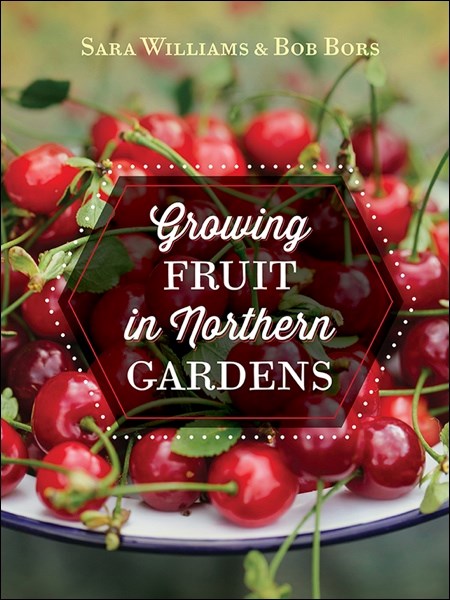By Sara Williams and Bob Bors
Published by Coteau Books
$39.95 ISBN 9-781550-509137
For those who desire to grow fruit in their own northern gardens, the comprehensive and visually inviting new reference book by horticultural experts Sara Williams and Bob Bors would be the logical place to begin.
This is a learned duo. Williams has penned numerous books on prairie gardening and leads workshops on diverse gardening topics. Bors is the head of the Fruit Breeding Program and an assistant professor in the Department of Plant Sciences at the University of Saskatchewan. He’s also globally known for his work with haskaps, dwarf sour cherries, and Under-the Sea coleus.
These Saskatchewanians possess a plethora of knowledge and experience, and they share it, along with up-to-date research, in Growing Fruit in Northern Gardens. It is a veritable encyclopedia (but far more fun) that instructs gardeners on everything from the basics, like soil preparation and pruning, to specifics on how to grow and maintain a healthy tree, shrub cane or groundcover. How to grow vine fruits and make the most of your hazelnuts are also covered.
Aside from the wealth of information on more than 20 species and more than 170 fruit varieties, this glossy-covered book is a joy to behold, with a proliferation of colour photographs. These are especially helpful when diagnosing plant disease and identifying insects. There are interesting sidebars, thoughtful organization and easy-to-read text.
The first key to the fruit growing in northern climes is hardiness. Winters in Zones 1 to 4 are often long and cold, so winter survival is critical. The authors explain that growing at northern latitudes also provides some benefits — fewer disease and insect problems and better colour and sweetness. There are also more antioxidants within northern grown fruits.
“What might be considered a super food grown elsewhere becomes a super-duper food when grown in the north!”
The advantages of growing your own fruit include enjoying just-off-the-vine freshness, the meditative state one might experience while pruning (“both a science and an art” ... think Buddhist monks and bonsai) and improving yard aesthetics. Readers learn about insect versus wind pollination, that most fruit does best with “full sun for at least half the day,” and mulch must be at least 10 centimetres to be effective.
I appreciated the numerous “fun facts” — how many of what we now consider weeds were “Old World plants that were deliberately introduced to the New World by immigrants for their culinary or medicinal value” and Canada Thistle is not Canadian: it’s from Eurasia, as are dandelions, which were “once used as a coffee substitute”. One of my major adversaries – portulaca (aka purslane) – was at one time “eaten as a vegetable.” I found the photos – like the root development images – instructive, and the authors’ personal anecdotes, such as Williams’ battle with deer, add a human touch.
A large section is devoted to apples, which are from the rose family. Apples once held top spot as Canada’s most important fruit, but that changed in the 1990s when blueberries were christened a “superfruit.” I was going to gift this book after reviewing it, but even living in Zone 7b/8a, I find it highly relevant. It’s staying with me.
— This book is available at your local bookstore or from the saskatchewan publishers group www.skbooks.com




